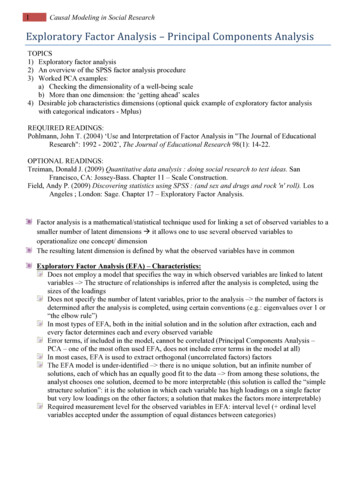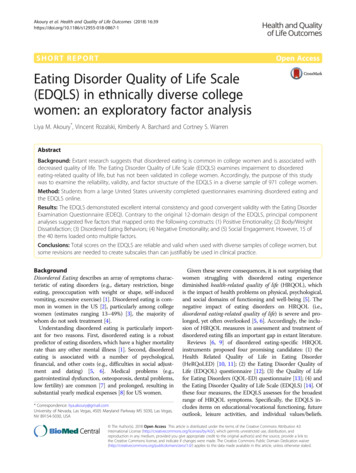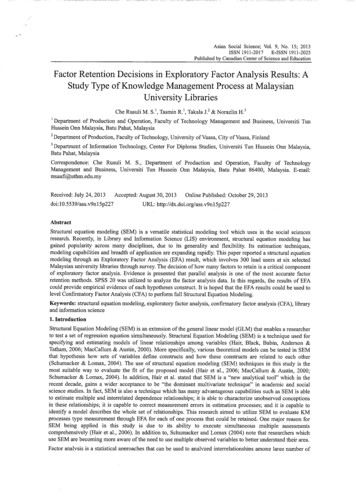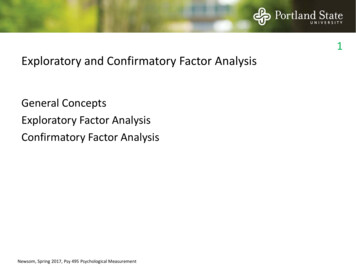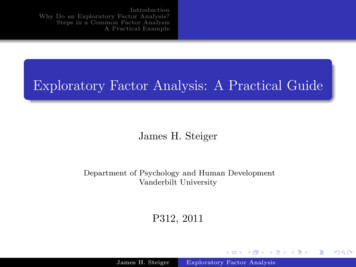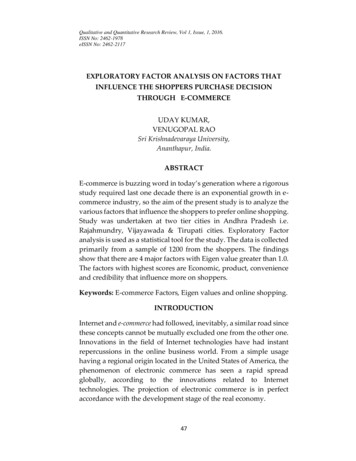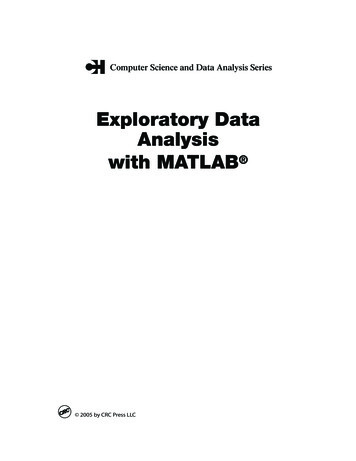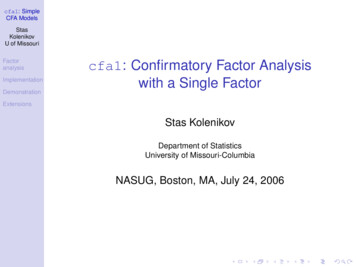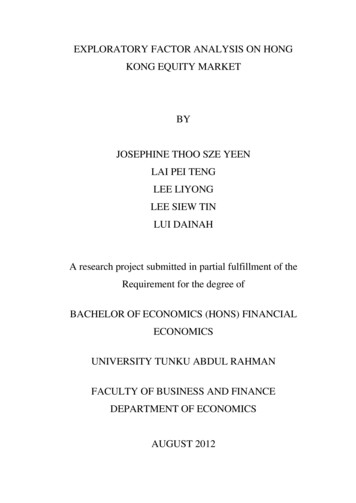
Transcription
EXPLORATORY FACTOR ANALYSIS ON HONGKONG EQUITY MARKETBYJOSEPHINE THOO SZE YEENLAI PEI TENGLEE LIYONGLEE SIEW TINLUI DAINAHA research project submitted in partial fulfillment of theRequirement for the degree ofBACHELOR OF ECONOMICS (HONS) FINANCIALECONOMICSUNIVERSITY TUNKU ABDUL RAHMANFACULTY OF BUSINESS AND FINANCEDEPARTMENT OF ECONOMICSAUGUST 2012
Exploratory Factor Analysis on Hong Kong Equity Market 2012Copyright @ 2012ALL RIGHTS RESERVED. No part of this paper may be reproduced, stored in aretrieval system, or transmitted in any form or by any means, graphic, electronic,mechanical, photocopying, recording, scanning, or otherwise, without the priorconsent of the authors.ii
Exploratory Factor Analysis on Hong Kong Equity Market 2012DECLARATIONWe hereby declare that:(1) This undergraduate research project is the end result of our own work and thatdue acknowledgement has been given on the references to ALL sources ofinformation be they printed, electronic, or personal.(2) No portion of this research project has been submitted in support of anyapplication for any other degree or qualification of this or any other university,or other institutions of learning.(3) Equal contribution has been made by each group member in completing theresearch project.(4) The word count of this project report is 12,310 .Name of Student:Student ID:1. JOSEPHINE THOO SZE YEEN10 ABB 019622. LAI PEI TENG10 ABB 019823. LEE LIYONG10 ABB 019454. LEE SIEW TIN10 ABB 013465. LUI DAINAH10 ABB 01413Date: 30th August 2012iiiSignature:
Exploratory Factor Analysis on Hong Kong Equity Market 2012ACKNOWLEDGEMENTSApart from the efforts of us, the success of any projects depends largely on theencouragement and guidelines of many others. We would like to take this opportunityto express our gratitude to the people who have been instrumental in the successfulcompletion of this research.We would like to express our deepest gratitude to our Supervisor, Mr. Lim Tze Jian,for his excellent guidance, caring, patience and as well as his vital encouragement andsupport in all the time of study and analysis of the project in the pre and post researchperiod. What is more, we are also grateful to Mr. Lim that willing to spend his busyschedule to taught us the use of the SPSS Software which helped to a great extent inour research.In addition, we would also like to extend our gratitude to Mr. Kuar Lok Sin whoprovides us valuable information as the guidance of our project. Besides, many thanksto our friends, acquaintances and lecturers, who directly and indirectly offeredsupport in any form throughout the tenure of our research execution.Last but not least, we would like to thank the authority of University Tunku AbdulRahman (UTAR) for providing us with a good environment and facilities to completethis research.Finally, a big applause for the members of this research, the guidance and supportreceived from each of the member contribution was the vital for the success of thisresearch. We grewto mature, delegated tasks, arrange time accordingly the worksand figure our strengths and weakness which would be great help in our future.iv
Exploratory Factor Analysis on Hong Kong Equity Market 2012TABLE OF CONTENTSPageCopyright PageiiDeclarationiiiAcknowledgementivTable of ContentsviList of TablesxList of AppendicesxiiList of AbbreviationsxiiiPrefacexivAbstractxvCHAPTER 1RESEARCH OVERVIEW11.0Introduction11.1Background of Hong Kong Stock Exchange (HKSE)11.2Significant Events31.3Problem Statement41.4Research Objectives51.5Research Questions61.6Hypotheses of Study61.7Significant of Study71.8Chapter Layout71.9Conclusion8LITERATURE REVIEW92.0Introduction92.1Factor that Affect the Stock Return in Past92.1.1Cash Flow102.1.2Book-to-Market112.1.3Dividend Yield122.1.4Leverage132.1.5Market Risk Measure by Beta142.1.6P/E Ratio15CHAPTER 2v
Exploratory Factor Analysis on Hong Kong Equity Market 20122.1.72.2Firm Size16Stock Pricing Model and Theory172.2.1CAPM Model172.2.2EMH Model192.2.3APT Model202.3Conceptual Framework222.4Hypothesis Development232.5Conclusion23DATA AND METHODOLOGY243.0Introduction243.1Data Sources243.2Research Technique used253.2.1Factor Analysis253.2.2Advantages of Factor Analysis263.2.3Ordinary Least Square (OLS)28CHAPTER 33.33.43.5Application of Model293.3.1Exploratory Factor Analysis293.3.2Factor Extraction303.3.3Factor Rotation313.3.4Factor Scoring and Factor Loading313.3.5Ordinary Least Square Regression323.3.6Coefficient of Multiple Linear lity Test36Multiple Linear Regression Model383.4.139Empirical ModelConclusion40DATA ANALYSIS414.0Introduction414.1Exploratory Factor Analysis424.1.1Factor Extraction424.1.2Total Variances Explanation464.1.3Chosen a Factor Rotation Method47CHAPTER 4vi
Exploratory Factor Analysis on Hong Kong Equity Market 20124.24.34.44.1.4Naming the Factor544.1.5Factor Score Loading59Multiple Linear Regression Model604.2.1Coefficient of Determination (R2)604.2.2Multicollinearity (VIF)624.2.3Test of Significant634.2.4Discussion Test of Significant654.2.5Multiple Linear Regressions674.2.6Discussion of Scope of Coefficient74Diagnostic Checking784.3.1Heteroscedasticity784.3.2Ramsey Reset Test794.3.3Normality Test80Conclusion83DISCUSSIONS, CONCLUSION AND IMPLICATIONS845.0Introduction845.1Summary of Statistical Analysis845.1.1Descriptive Analysis855.1.2Factor Rotation855.1.3Factor Extraction865.1.4Significant of P-Value865.1.5Factor Score & VIF875.1.6Multiple Linear Regressions87CHAPTER 55.2Discussions of Major Findings895.3Implications of Study905.3.1Investor Perspective905.3.2Market Perspective915.4Limitations of Study915.5Recommendations for Future vii
Exploratory Factor Analysis on Hong Kong Equity Market 2012LIST OF TABLESTable 4.1: Output of Exploratory Factor Analysis in year 2000Page3Table 4.1.1: Output of EFA in year 20013Table 4.1.2: Output of EFA in year 20088Table 4.2: Amount of Total Variances to be Explained21Table 4.3: Correlation Matrix with Direct Oblimin Method24Table 4.4: Output of Varimax Rotation Method25Table 4.5: Output of Quartimax Rotation Method26Table 4.6: Output of Equamax Rotation Method30Table 4.7: Output of Direct Oblimin Rotation Method32Table 4.8: Output of Promax Rotation Method33Table 4.9: Varimax Rotation Loading in year 200034Table 4.10: Varimax Rotation Loading in year 200135Table 4.11: Varimax Rotation Loading in year 200836Table 4.12: Component Score Covariance Matrix36Table 4.13: Summary of R2 Result from year 2000 to 201037Table 4.14: VIF for year 2000 to 201043Table 4.15: Probabilities for Each Coefficient for year 2000 to 201050Table 4.16: Summary of Coefficients for Each Year71Table 4.17: Summary of Regression Analysis in year 200073Table 4.18: Summary of Regression Analysis in year 200175Table 4.19: Summary of Regression Analysis in year 200877Table 4.20: Summary of Heteroscedasticity Result for Year 2000 to 201082Table 4.21: Summary of Ramsey RESET Test for year 2000 to 201083viii
Exploratory Factor Analysis on Hong Kong Equity Market 2012LIST OF APPENDICESPageAppendix A: Factor Extraction and Total Variances Explanationfor the Year 2000 until 2010104Appendix B: Factor Rotation and Factor Loading for the Year 2000until 2010115Appendix C: Multiple Linear for the Year 2000 until 2010126Appendix D: Diagnostic Checking: Heteroscedasticity Test for theYear 2000 until 2010137Appendix E: Diagnostic Checking: Ramsey Reset Test for the Year2000 until 2010148ix
Exploratory Factor Analysis on Hong Kong Equity Market 2012LIST OF ABBREVIATIONSAMSAutomatic Order Matching and Execution SystemAPTArbitrage Pricing TheoryCAPMCapital Pricing ModelCFCash FlowCRSPCentre for Research in Security PricingDIVDividend YieldEFAExploratory Factor AnalysisEMHEfficient Market HypothesisETFExchange Traded FundFZFirm SizeGLSGeneralized Least SquareHKSEHong Kong Stock ExchangeHKEXHong Kong Exchange and CurrencyHKDHong Kong DollarIPOInitial Public OfferingLEVLeverageMBVMarket-to-Book ValueNYSENew York Stock ExchangeOLSOrdinary Least SquareP/EP/E RatioROIReturn on Investmentx
Exploratory Factor Analysis on Hong Kong Equity Market 2012PREFACEThis research is a study on the determination of the Stock Return in Hong Kong StockMarket with the use of the method of Exploratory Factor Analysis.The studyconducted is based on the data obtained upon from year 2000 until 2010 from the 45listed companies. In here, a special thanks to our supervisor, Mr. Lim Tze Jian.Without his encouragement and guidance this project would not be materialized.Further we would like to thank our second examiner, Mr. Keh who pointed out on ourwork development so that we are able to fix it constructively. Also, Miss Lim, thecoordinator for the briefing and guidance all along the period of the final year project.xi
Exploratory Factor Analysis on Hong Kong Equity Market 2012ABSTRACTThis research adopt an alternative way to determine the stock returns in 45 selectedcompanies which are listed in Hong Kong Stock Exchange (HKSE ) from year 2000to 2010. Additionally, exploratory factor analysis is undertaken in order to obtain asuperior result as it allows discovering the hidden factors in a set of variables whichexplain stock return. Besides, we employ the Ordinary Linear Square (OLS) methodto examine the relationship between the stock returns and factor variables throughdimension reduction technique. In our study, we found that in year 2001, there are sixfactors, which are cash flow, leverage, firm size, dividend, market-to-book value andP/E ratio will affects stock returns in HKSE. Meanwhile, in year 2008, there are onlyfour factors which are similar to year 2001 excluding market-to-book value and P/Eratio. Besides, there are five factors for year 2000 and the remaining years. Thosefactors are same as year 2001, excluding P/E ratio. On the other hand, we found thatthe model we employed in year 2000 is significant to explain the stock returns,whereas others are not.Keywords: Cash Flow (CF), Leverage (LEV), Firm Size (FZ), Dividend (DIV),Market- to- book Value (MBV), Hong Kong Stock Exchange (HKSE), Hang SengIndex (HSI).xii
Exploratory Factor Analysis on Hong Kong Equity Market 2012CHAPTER 1: RESEARCH OVERVIEW1.0IntroductionSeveral variables which are significant to stock returns can be determined from theeconomy and financial perspectives. Meanwhile, the purpose of this research projectis to investigate the hidden factors in a set of variables which will generally affect thestock returns in Hong Kong Stock Exchange (HKSE) by adopting exploratory factoranalysis. The major objective of this chapter is to enable the readers to develop abetter understanding about the topic layout which are concerned in this study.Alternatively, description about the background of HKSE, significant events, problemstatement, research objectives, research questions, hypotheses and significant of thestudy as well as chapter layout will be included in this chapter. Lastly, the structure ofthis study from chapter 2 until chapter 5 will be more detailed in further chapters.1.1Background of Hong Kong Stock Exchange (HKSE)Hong Kong is one of the world‟s leading international financial centers. It is a majorcapitalist service economy characterized by low taxation and free trade. Besides, thecurrency of Hong Kong, Hong Kong dollar (HKD), is the ninth most traded currencyin the world. Hong Kong has remained as the world‟s free economy, according to theIndex of Economic Freedom since the inception of the index in year 1995.The Index measures restrictions on business, trade, investment, finance, propertyrights and labour associated with consideration of the impact of corruption,government size and monetary controls in 183 economies.Hong Kong is also the only country to have ever scored 90 points or above on the 100points scale. Furthermore, Hong Kong Stock Exchange (HKSE) is the sixth largest inPage 1 of 158
Exploratory Factor Analysis on Hong Kong Equity Market 2012the world, with a market capitalization of about US 2.97 trillion. In year 2006, HongKong Exchanges and Clearing (HKEX) have an average daily turnover of 33.4billion, which is 12 times compared to Shanghai. In year 2009, Hong Kong hasbecome the largest center of initial public offerings (IPO) capital in the world.Hong Kong Stock Exchange (HKSE) is located in Victoria, Hong Kong. It is the thirdlargest stock exchange market in Asia in terms of market capitalization, after TokyoStock Exchange and Shanghai Stock Exchange. It is also the sixth largest stockexchange market in the world. HKSE is the holding company of The Stock Exchangeof Hong Kong Limited, Hong Kong Futures Exchange Limited and Hong KongSecurities Clearing Company Limited. Moreover, HKSE has successfullytransformed Hong Kong's financial services industry from a domestically focusedmarket to become a central market place in Asia by attracting investment funds andconverging the market organization from all over the world.Apart from this, HKSE was formed in year 1947. It merged by the first formalsecurities market, the Association of Stockbrokers in Hong Kong (1891) and thesecond exchange, the Hong Kong Stockbrokers‟ Association which established inyear 1921. After Second World War, HKSE was re-established and merged withother four notional exchanges in the end of 20th century.HKSE also used electronic trading as their trading system by first introduced acomputer-assisted trading system on 2 April 1986. In year 1993, HKSE launched the“Automatic Order Matching and Execution system” (AMS), which was replaced bythe third generation system (AMS/3) in October 2000.Meanwhile, the operations of HKSE are organized into focused units which directlysupervised and controlled by management and the board of directors. HKSE acts asthe operator and frontline regulator of the central securities and derivativesmarketplace in Hong Kong. It provides services such as comprise trading, clearingand settlement, depository and nominee service, and information services.Page 2 of 158
Exploratory Factor Analysis on Hong Kong Equity Market 2012The vision of HKSE is to become the commercial entity with public duties andresponsible for the operation of the central marketplace. In addition, its initiativesreinforce Hong Kong's standing as an international financial centre and support thecountry's further development. The mission statement of HKSE for year 2020 is tocreate and operate international public financial markets actively in Hong Kong.Until the end of April 2012, there were 1,516 companies listed under HKSE with themarket capitalization of 20,231 billion Hong Kong dollar. The trading securities inHKSE include equities, derivative warrants, Exchange-Traded Fund (ETF), bonds,stock and index options, and futures. Apart from securities products, HKSE alsoprovides derivatives products, clearing services, data products, issuer services andhosting services.1.2Significant EventsHang Seng Index (HSI) is a market capitalization-weighted stock market index inHong Kong. It is the most widely quoted barometer for the Hong Kong economywhich used to record and monitor daily changes of the largest companies in the HongKong Stock Market.In 2000 and 2002 respectively, the Mini-HIS futures and options contracts werelaunched to serve the trading and hedging needs of retail investors. This enablesinvestors to manage the investment risk which eventually affect the stock marketmore effectively.On 15 September 2008, Lehman Brothers Holdings Incorporate filed for Chapter 11bankruptcy protection in New York and triggered the bankruptcy of the LehmanBrothers group of companies. The collapse of Lehman Brothers has sparked manymajor regulatory developments in Asia, including Hong Kong.Hong Kong was significantly affected by the bankruptcy of the Lehman Brothers.Page 3 of 158
Exploratory Factor Analysis on Hong Kong Equity Market 2012The domestic stock market of Hong Kong fell abruptly. Hang Seng Index brokebelow 16,500 and interbank liquidity was also tightened. There was rumors sparkedrun on Bank of East Asia, reflecting some panic response by investors and financialinstitutions. The exports of Hong Kong also affected amid the Lehman incident.Besides, a global financial crisis in 2008 has caused stagnation in development ofHong Kong. According to Zhang Yang (2009), Hong Kong‟s economic growth wasmoderated significantly from 6.4% in 2007 to 2.5% in 2008 during the financialcrisis.Investors lost confidence towards Hong Kong stock market lead to the sunk of HongKong‟s capital market. Infrastructure development in the region was suspendedcaused the unemployment rate of Hong Kong increases.Famous for its high efficiency and transparency, Hong Kong Government launched aseries of economy-boosting infrastructure investment to ease the financial panic. TheTen Major Infrastructure Projects and a large number of small and medium localprojects were initiated by Hong Kong Government to boost the economy.As the results, the strong government support and proper stimulus plans have broughtup the economy of Hong Kong, this country started to show real growth in year 2010after a year of stagnation. Hong Kong‟s economy is expected to remain competitivein the coming decade.1.3Problem StatementThere are numerous studies have been done by researchers such as Akdeniz et al.(2000), Banz (1981), Lakonishok et al. (1994), Wong, K, and Lye, M. (1990) andothers to determine the fundamental factors which will affect the stock returns instock market.Page 4 of 158
Exploratory Factor Analysis on Hong Kong Equity Market 2012Meanwhile, several of independent variables especially cash flow, firm size, leverage,dividend, market-to-book value and PE ratios have been studied extensively by theexperts across the world.In finance, return on investment (ROI) is the ratio of money lost or earned relative tothe amount of money used on an investment. Stock returns are the returns that aninvestor receives in stock market. It may be in the form of dividends which rewardingshareholders by the companies from time to time or as capital gain through trading insecondary market. Investors able to receive favourable stock return if they purchasestocks at lower price and sell at a higher price in the secondary market. Nonetheless,instead of using Capital Asset Pricing Model (CAPM), there are still many alternativeways have been developed to measure the stock returns.1.4Research ObjectivesIn this research, we use exploratory factor analysis to examine the variables thataffect stock market returns. We intend to find the hidden factors that are measured byobserved variables, and use these hidden factors (factor scores) to regress on ourdependent variable (stock returns). Consequently, this should enable us to obtain asuperior result compared to merely regressing the observed variables on thedependent variable (stock returns).Page 5 of 158
Exploratory Factor Analysis on Hong Kong Equity Market 20121.5Research QuestionsEstimation of stock returns is crucial for investors, researchers, stock brokers andother interest groups. The quality of stock market analysis and the amount of riskeach individual is willing to take help to determine the stock market returns that aninvestor could earn. Dissimilar to bond market returns, stock returns are capricious innature.Hence, it is essential for the investors to speculate on the technical analysis,fundamental basis and know the variables which may influence them. This inspiresour interest to do further in depth study as well as figure out the relationship betweenour dependent and independent variables.The research questions of our study are whether the accounting information isimportant to explain the movement of stock market and what are the variables whichwill affect the stock market returns.1.6Hypotheses of the StudyA main testable hypothesis has been developed to guide the direction of our study.H0: The factor variables of Cash Flow (CF), Leverage (LV), Firm Size (FZ),Dividend (DIV), Market-to-Book Value (MBV) and P/E Ratio (P/E) haveinsignificant effect on price of component stocks in Hong Kong Stock Exchange(HKSE).H1: The factor variables of Cash Flow (CF), Leverage (LV), Firm Size (FZ),Dividend (DIV), Market-to-Book Value (MBV) and P/E Ratio (P/E) havesignificant effect on price of component stocks in HKSE.Page 6 of 158
Exploratory Factor Analysis on Hong Kong Equity Market 20121.7Significant of the StudyOne of the contributions of this study is to reveal a better way which provides moreprecise estimation of stock returns for investors, researchers, stock brokers and otherinterest group. For example, CAPM has poor empirical record and this is invalid theuse in applications.Besides, exploratory factor analysis is functional and simplest models in finance.Thenceforth, it analyses the appropriate and relevant factors and able to determine thehidden factors in a set of variables to explain stock returns.In this study, we include the data of 10 years to determine Hong Kong stock returns,which is longitude study. This is beneficial as it enable us to track changes over theyears to figure out the impact of significant events such as U.S crisis and 2007subprime crisis as well as the stability of the coefficients before and after theseevents.1.8Chapter LayoutFor this study, we include the background of Hong Kong Stock Exchange (HKSE),problem statement, research objective, research question, hypothesis and significanceof study in our chapter 1.Chapter 2 - Literature reviews in some relevant journal articles which are related toour study, including the introduction, literature reviews and hypothesis development.Chapter 3 - Methodologies consisting data sources, research techniques, definition offactor analysis, advantages of the factor analysis, definition of ordinary least square(OLS), data analysis and the coefficient of multiple determinations.Page 7 of 158
Exploratory Factor Analysis on Hong Kong Equity Market 2012Chapter 4 - Data analysis which discussing how to determine factor rotation andnaming the variables. Besides, test of significant by using OLS method will also bediscussed in this chapter.Finally, Chapter 5 reveals the conclusion that can be drawn from this study. Apartfrom this, other sections such as major finding, implication, limitation andrecommendation of the study will also be included in this chapter.1.9ConclusionThis present study is focused on examining an alternative way to explain stockreturns. Thus, this study attempts to determine factors which have a significantexplanatory power to influence stock returns among 45 companies in Hong KongStock Exchange (HKSE) for the period 2000 to 2010 by using the exploratory factoranalysis. Nevertheless, some limitations of the CAPM have been found whencompared to the actual returns and challenges the assumption of a single risk factorthat has been made previously. Thus, exploratory factor analysis is adopted in orderto explore the hidden elements and provide more precise estimation of stock returnfor investors, researchers, stock brokers to predict future expected return. A review ofthe relevant literature is present in chapter 2 to indicate that stock returns isdetermined by multiple factor such as cash flow, firm size, and market- to- bookvalue, dividend, P/E ratio and leverage.Page 8 of 158
Exploratory Factor Analysis on Hong Kong Equity Market 2012CHAPTER 2: LITERATURE REVIEW2.0IntroductionIn the previous chapter, we have discussed about the general background of HongKong stock market and significant events of financial market that happened in HongKong between years 2000 to 2010. Besides, we also discussed about the problemstatement, general and specific objectives, and research question of our study.Moreover, testable hypothesis, significance and chapter layout of our study are alsobeen discussed. Thenceforth, we will discuss about the results of similar studieswhich have been done by previous researchers in this newly chapter.There are several ways or types of methodologies to determine the factors whichmight affect the stock returns. Hence, it is crucial to refer for different journals whichhave been conducted by previous researchers in order to gain a wider range ofperspective and outcomes. Forte and shortcoming such as limitations of previousresearches can be taken into consideration to improve this study.Recently, there are various types of theories and methods that have been proposed toexamine those variables which will affect the stock market returns. Although previousliterature covered a wide variety of theories and methodologies, our reviews will onlyfocus on four major themes that emerge repeatedly throughout the literature reviewed.One of the major themes is the variables that can affect the stock market returns,which including cash flow, market-to-book value, dividend yield, leverage, marketrisk measured by beta, P/E ratio and firm size. Then, follow with the explanation ofCAPM, efficient market hypothesis (EMH) and the arbitrage pricing theory (APT).Page 9 of 158
Exploratory Factor Analysis on Hong Kong Equity Market 20122.1Factors That Affected Stock Market Returns in PastLiterature2.1.1 Cash FlowDaniat and Suhairi (2006) claim that some significant information such asinvesting activities and gross profit has an impact on expected return of sharesin Arab from year 2000 to 2009 by using Ordinary Least Square (OLS)method. However, Meythi (2006) strongly disagree that cash flow fromoperating activities is insignificant to the expected return in Indonesia. Theresearch is based on 100 manufacturing firms in Bursa Efek Indonesia (BEJ)during year 1992 to 2002 by adopting OLS method. It shows that profitspersistence as intervening variables, cash flow from operating activities doesnot affect stock price.The cash flow of an asset has two important characteristics, which are degreeof its movement with consumption (covariance) and cash flow duration.Based on the consumption-based models of Abel (1999) and Bansal andYaron (2004), they state that covariance determines stocks exposure tosystematic risk.On the other hand, Lettau and Wathter (2005) claim that there is a negativerelation between cash flow duration and stock price from monthly data year1952 to 2002 by using risk-based model. This is because they strongly believethat high cash flow duration will lead to a lower expected return. Besides, Anget al. (2006) claim that there is a negative relationship between the cash flowvolatility and stock returns in New York from year 1963 to 2010 due tosystematic risk and special volatilities.According to Bansal, Dittmar, and Lundblad (2005) argued that in SydneyPage 10 of 158
Exploratory Factor Analysis on Hong Kong Equity Market 2012from year 1964 to 2002 shown that cross-sectional variation of risk premiumcan affect by cash flow covariance (Cov), which is using OLS regressions.Higher cash flow covariance will lead to a higher risk premium, beta andconsequently a higher return in CAPM.For instance, an asset with positive (negative) Cov, its cash flow commovesmore (less) with aggregate consumption than aggregate consumption. Lettauand Wachter (2007) agree with risk premium affect by cash flow durationfrom 1952 to 2002 in by using OLS method in United States of America.Meanwhile, large variation in cash flow in cross-sectional cause cash flowduration provides additional explanatory power through a second-orderinteraction term with cash flow covariance. Therefore, it can explain by twoasset have difference return with different cash flow durations such as growthstock portfolios, thus it is necessary to account for cash flow duration.2.1.2 Market –to–BookThe literatures of the relationship between cross sectional factors and stockreturns in Hong Kong. Chan, Hamao, & Lakonishok (1991) argue that there issignificant relation between market to book and returns in Japanese stock byusing OLS method. A poor prospects‟ firm has been signaled by low ratio ofmarket-to-book equity and low stock price tends to have greater expectedstock returns than strong prospects‟ firm.Meanwhile, some researchers claim that there is a positive relationshipbetween market-to-book equity and stock returns in U.S. stock market fromyear 1979 to 2000 by using OLS method. When book-to-market equityincreases, stock returns increase with the successful of detecting the marketinefficiency by diverse instrumental variables, which can detects the largerpotential profits. Moreover, some researchers claim that positive relationshipbetween market-to-book and stock returns because most of the investorsPage 11 of 158
Exploratory Factor Analysis on Hong Kong Equity Market 2012merely have a preference for investing in „superior firm‟ with high market-tobook and growth. Thenceforth, the firm‟s stock price and stock returns willcontinue to grow (Stattman, 1980; Rosenberg, Reid, & Lanstein, 1985).2.1.3 Dividend YieldHess (1981) makes use of the data from January 1926 until December 1978from the Centre for Research in Security Prices (CRSP) by OLS method. Thisresearcher discovers a different view on the relationship between stock returnand dividend yield, which they are not constant across securities.According to Blume (1980) that using the data from year 1936 to 1976, heclaims that there is a positive relationship between the stock returns anddividend yield by using OLS method. In this research, the risk-adjustedreturns on dividend-paying stocks increased monotonically with theanticipated dividend yield throughout the 41 years ending in 1976.This means that higher dividend yield will leads to greater stock returns as itindicates good cash flow, profitability and company is generally in excellentperformance. Besides, this evidence is consistent to Lemmon and Thanh(2008), which employing the data from January of 1973 until December of20
Exploratory Factor Analysis on Hong Kong Equity Market 2012 viii LIST OF TABLES Page Table 4.1: Output of Exploratory Factor Analysis in year 2000 3 Table 4.1.1: Output of EFA in year 2001 3 Table 4.1.2: Output of EFA in year 2008 8 Table 4.2: Amount of Total Variances to be Explained 21
